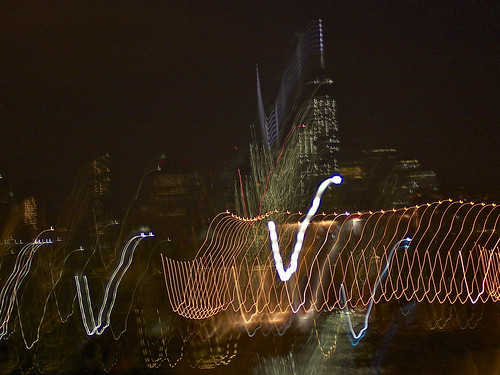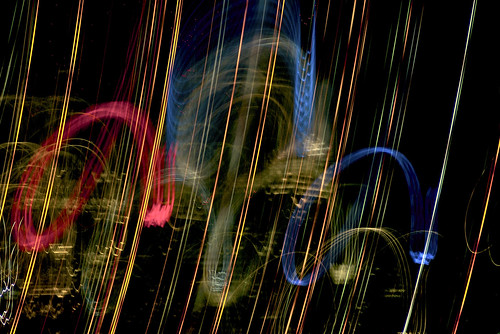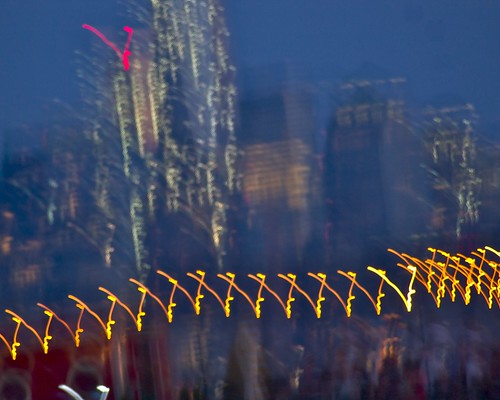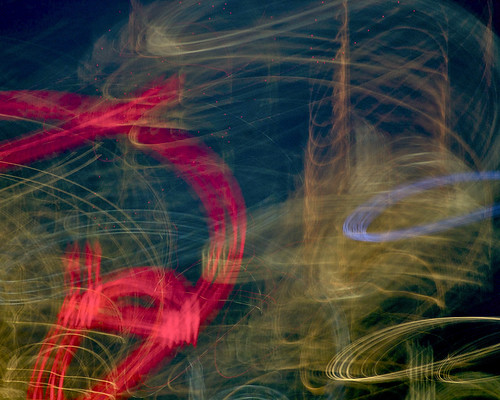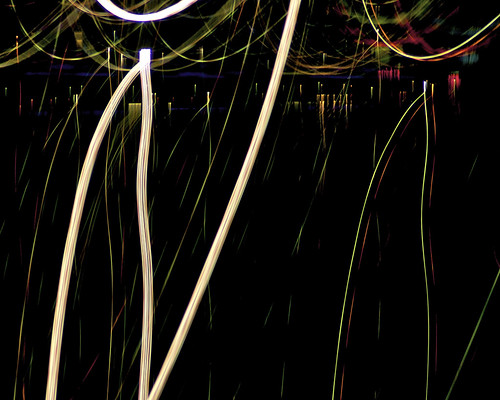by Bill Benzon
Timothy Morton. Hyperobjects: Philosophy and Ecology after the End of the World. University of Minnesota Press 2013. 229 pp.
This is a strange book, for it is three. There is the book that is easy to praise for its range of topics – quantum mechanics, La Monte Young, global warming, The Matrix, the Prisoner’s Dilemma, for example – and its quasi-virtuoso stylistic versatility. There is, as well, the book that is easy to criticize – though I’m sure some would regard that as too mild a word – for its conceptual instabilities, lapses in logic, and misreading of science.
And there is another book, the one leaking out of the cracks and pores in the first two. That book has the scattered beginnings of a framework in which we can construct a viable approach to the future. That's the book I'm writing about, making this essay as much an interpretation of as a review of Morton's fine Hyperobjects.
Hyperobjects and Objects
Hyperobjects are “things that are massively distributed in time and space relative to humans” (p. 1). What isn’t a hyperobject is an object. Kumquats, automobiles, palm trees, squids, geosynchronous satellites, Olympic records, a promise, a rooster’s crow, these are all objects in the philosophical sense of the word. In the first paragraph of the book Morton lists these examples: the Lago Agrio oil field, Florida Everglades, the biosphere, the Solar System, “the sum total of all the nuclear materials on Earth; or just the plutonium, or the uranium,” Styrofoam, plastic bags, or “the sum of all the whirring machinery of capitalism.”
The philosophical sense of object is not quite the same as the ordinary sense, which tends toward physical things that are neither very large nor very small. Roughly speaking, for Morton and proponents of other object oriented ontology (OOO) – a recent school of Continental philosophy – anything that can be designated by a noun or a noun phrase is an object. Anything. Including, of course hyperobjects.
The point is that all objects are of the same ontological kind. No objects are higher than others, as in the old Great Chain of Being, where animate things are higher than inanimate, animals higher than plants, human higher than animals, angels above humans, and God at the very top. Objects may well contain other objects as components, but they cannot be reduced to those components – a critical feature of objects according to OOO.
Hyperobjects, of course, are objects as well. But they can be difficult to grasp as such because they are, in Morton’s formulation, massively distributed in time and space. They are also viscous, nonlocal, phased, undulate in time, and “exhibit their effects interobjectively” (p. 1), each of which is discussed in a chapter. Morton’s exposition goes through quantum mechanics, relativity, complexity / chaos, and a bit of philosophical wizardry. The upshot is that it begins to look like objects of the ordinary philosophical kind are, for all practical purposes, hyperobjects as well.
Stephen Muecke noticed this when reviewing Hyperobjects for the Los Angeles Review of Books:
Finally, even simple objects are “hyper” to the extent that they are in or out of phase, not being exactly “equivalent to themselves” at any given time. A paper clip is also a SIM card remover. An apple is also a baseball in a high-spirited backyard game … This lack of discreteness of objects, which tends to make every object somewhat hyperobjective, is underscored by the final property of Part 1, interobjectivity, “in which nothing is ever experienced directly, but only as mediated through other entities in some shared sensual space.”
Now, Morton might object that Muecke doesn’t understand, for the effects he lists in that paragraph belong to ordinary objects as analyzed and construed in OOO. But I don’t buy that, not quite.
In the first place, under OOO ordinary objects turn out to be very strange things, as strange as Morton’s hyperobjects. Though physical scale IS important, I fear that strangeness trumps scale in Morton’s exposition. Even for Morton himself.
He equivocates in his account of quantum mechanics. His argument seems to be that though individual quanta, strange though they are, are exceedingly small, the quantum realm itself is massive (cf. pp. 44-45). His exposition here is fuzzy at best.
The problem continues in his account of phasing, which draws on complexity theory and chaos, where high-dimensional spaces are used to analyze the dynamics of physical systems. Morton’s principle example is the well-known Lorenz Attractor, which Lorenz discovered while analyzing weather data. The weather system, of course, is massively distributed in time and space. But the same mathematics is used to analyze the behavior turbulent flow in one’s kitchen sink. It is not at all massively distributed in time and space, but the analysis employs a phase space of exceedingly high dimensionality. That space is no easier to grasp than that for the weather system, nor any harder either.
So yes indeed, as Morton says (p. 139): “Hyperobjects undermine normative ideas of what an “object” is in the first place.” This is pushing things rather hard, but I’m going to do it anyhow: For all practical and philosophical purposes all objects are hyperobjects. Morton may have coined the term to characterize certain very large objects – global warming in particular – but the properties under which he conducts his analysis of those hyperobjects – being viscous, nonlocal, phased, undulating in time, and interobjectively – apply to pretty much all objects.
And that is just fine. Far from weakening his argument, it makes it stronger. What Morton has done, in effect, is to use an account of certain large-scale phenomena as a vehicle for for a more general account of the physical world.
Now and Evermore, the (Real) Singularity
Global warming, Morton’s paradigmatic hyperobject, IS massive in both spatial and temporal scale, encompassing and extending into the distant future.
And it changes everything.
Even casual conversation.
As Morton observes (p. 102) conversation about the weather is a prominent component of the trivial chatter that lubricates our social lives. It’s background discourse, as the weather itself is the background against which we live our lives. But weather can no longer be merely the background, for it is forcing us to change the way we interact with the planet and, necessarily, with one another. As for the weather conversation, it now carries undertones of existential risk.
But the end of the world? Yes. In a sense.
Did you grow up watching The Jetsons on TV and dream of jetpacks? Did you see Disney’s Our Friend the Atom, with its prophesy of endless clean energy from atomic power? Did you see Kubrick’s 2001 and wonder when we’d see the Monolith? Or are you a believer in the coming Singularity, when computers will come to out-think us and may or may-not let us use nanotechnology to endow our bodies with never-ending youth?
Well, it’s happened.
That BIG EVENT IN THE FUTURE when everything is supposed to change? Well, it IS HAPPENING RIGHT NOW. Global warming is the first child of the Anthropocene. It snuck up on us while we weren’t looking. Morton double dates it: to 1784, the birth of the steam engine, and 1945, the explosion of the first atomic bombs.
This is not only a historical age but also a geological one. Or better: we are no longer able to think history as exclusively human, for the very reason that we are in the Anthropocene. (p. 5)
It ends the world in a special sense of “world”, just as Francis Fukuyama had a special sense of “history” in mind when he declared it at an end back in 1989. Whether or not Fukuyama was right about history ending in that special sense, it has kept chugging right along in the ordinary sense.
Of course, the world has not ended in the ordinary sense; the earth hasn’t been blasted to smithereens by a wandering asteroid, nor melted in the sun’s dying explosion, nor conquered by super intelligent lizard beings from outer space. But Morton is right in declaring the world at an end.
In a special sense.
Hyperobjects are a good candidate for what Heidegger calls “the last god,” or what the poet Hölderlin calls “the saving” power that grows alongside the dangerous power. We were perhaps expecting an eschatological solution from the sky, or a revolution in consciousness – or, indeed, a people’s army seizing control of the state. What we got instead came too soon for us to anticipate it. (p. 21)
Whatever your hopes or fears for the next major era in human history, Morton is telling us that it has already happened and it is us. Not merely us, of course, for Morton sets microbes, nebulae, siroccos, falafel carts, giant squids, dandelions, NGOs, bonobos, and the worldwide web all on the same ontological footing, neither above nor below us.
A Brave New World
We face many challenges on the new savanna. It’s not as though it is pristine territory. On the contrary, it is scared with the tribulations of civilizations in collapse, for that’s what it is going on around us, even as many have technophilic dreams of a coming utopia. And one of those scars is nuclear waste, which will be with us for millennia to come.
What do we do?
Thomas Sebeok, the semiotician, proposed that knowledge of and access to the waste be entrusted to an “atomic priesthood.” Morton rejects that idea and turns to the Nuclear Guardianship movement (121):
Guardianship, care–to curate is to care for. We are the curators of a gigantic museum of non-art in which we have found ourselves, a spontaneous museum of hyperobjects. The very nature of democracy and society–Whom does it contain? Only human? Whom, if any, can it exclude?–is thrown into question. The atomic priesthood would prevent others from knowing the truth. The attempt to care for hyperobjects and for their distant future guardians will strikingly change how humans think about themselves and their relationships with nonhumans. This change will be a symptom of a gradually emerging ecological theory and practice that includes social policy, ethics, spirituality, and art, as well as science. Humans become, in Heidegger’s word, the guardians of futurality, “the stillness of the passing of the last god.” Nuclear Guardianship has suggested encasing plutonium in gold, that precious object of global reverence and lust, rather than sweeping it away out of view. Encased in gold, which has the advantage of absorbing gamma rays, plutonium could become an object of contemplation. Set free from use, plutonium becomes a member of a democracy expanded beyond the human.
While I wished Morton had said more about this proposal – I’d like to know specifically about encasing plutonium in gold – I like its spirit. Don’t sweep the trash away; acknowledge it and care for it.
It’s in this spirit that I read the recent emergence of ruins photography, photographs of abandoned and decaying buildings and other infrastructure. In the spirit of Shakespeare’s Prospero – “This thing of darkness / I acknowledge mine” – these artists are creating the means through which we can claim and acknowledge the fruits of civilization-wide failure. And we can move forward only by acknowledging where we have been.
Morton talks of “a time of sincerity: a time in which it is impossible to achieve a final distance toward the world” (p. 130). Not even from our trash and ruins can we, should we, distance ourselves. Nothing is “over there” where it is hidden, out of sight, out of mind. All is / needs to be open.
The ruins of Fukuyama’s terminated history are ready to be remixed and written into a new order of things. THAT is how I read the graffiti that has traced its way over the urban world in the last half century. As I have written previously on 3QD, graffiti emerged outside of existing institutions, created by marginalized peoples, and has become a way of reclaiming urban space for the disposed. Much of this graffiti has been and is being painted on the surfaces of ruined and abandoned industrial buildings.
Let me suggest, by way of closing, that we treat the graffiti that’s been painted and written – coincidentally, during the period what we became aware of global warming – as a single work of art, a hyperobject, one created, not by a single prepossessing genius, but by two or three generations (so far) of loosely-knit graffiti crews: The World Wide Wall.
❖ ❖ ❖
I created the photographs specifically for this review. I went to the bank to the Hudson River – I live in Hoboken, NJ – Saturday evening and photographed the Manhattan skyline while moving the camera. They are thus traces of interobjectivity, with traces from different buildings and other objects crossing one another, but yet preserving some order.
I have written extensively about object-oriented ontology at New Savanna, and about Morton’s work. I have recently been blogging specifically about Hyperobjects.

